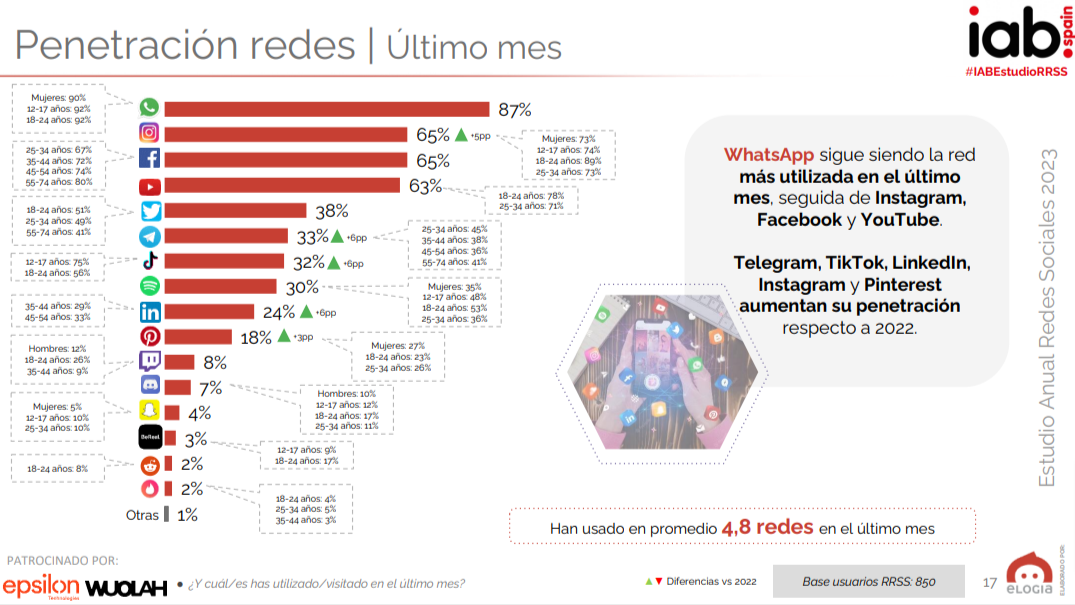How to create a Social Media Plan in 10 Steps for 2024

The effectiveness of digital marketing today depends largely on a well-thought-out social media strategy. Whether you are a digital marketing expert, a professional exploring this terrain, or an entrepreneur looking to capitalize on the enormous potential of these platforms, understanding the most popular social networks is crucial. This knowledge will allow you to maximize the reach of your brand, connect with the right audience, and optimize your social media marketing strategy.
In this context, beyond the number of users of each platform, it is essential to assess whether the social network aligns with your brand’s image and whether your target audience is active on it. Effective social media management involves not only presence; it also requires strategic selection and expert management of the most relevant platforms for your business. Below, we present a detailed 10-step guide to creating and executing a successful social media plan in 2024, taking full advantage of current trends and available tools.
Tabla de contenidos
10 Steps to Create Your Social Media Plan
1. Analysis and Starting Point:
The initial phase of any social media plan requires thorough analysis. For this, tools like Google Analytics, BuzzSumo, and SEMrush are essential. They allow you to get a clear understanding of the current state of your digital presence and the market in general. For example, it is fundamental to recognize the prevalence of platforms like Facebook, which continues to be one of the most used networks with more than 3 billion users, and others like YouTube and WhatsApp, which dominate in their respective categories. This initial analysis lays the foundation for a well-founded strategic plan.
2. Know Your Audience:
Deep knowledge of your audience is key to the success of any social media strategy. Tools like Facebook Insights and Twitter Analytics offer valuable data on the characteristics and preferences of your audience. In addition, it is crucial to be aware of trends on growing platforms such as TikTok, which currently reaches more than 1.2 billion users and has become a vital channel for connecting with a younger segment. Implementing surveys through tools like SurveyMonkey can also provide a more direct and detailed insight into the preferences and expectations of your audience.
3. Competitor Strategy:
Understanding your competitors’ strategies is crucial. How are they using social media? What type of content generates the most interactions? Tools like Ahrefs and SimilarWeb offer deep insights into your competitors’ tactics, while Brandwatch can be useful for monitoring their mentions and online activity. For example, if a competitor is successful on Instagram thanks to a series of interactive videos, could this tactic be adapted to your own strategy?
4. Definition of SMART Goals:
Clarity in objectives is fundamental. Do you want to increase brand awareness, drive sales, or improve customer loyalty? Set goals that are Specific, Measurable, Achievable, Relevant, and Time-bound. Tools like Trello and Asana can be useful for organizing these goals and monitoring their progress. For example, a goal could be “Increase web traffic from our social networks by 25% in the next six months.”
5. Analysis of Your Website:
Your website acts as the hub of your digital presence. Is it optimized to capture and convert social media traffic? Tools like Woorank and Hotjar can help assess and improve the user experience on your site. Additionally, Google’s mobile compatibility test ensures that your website is accessible to mobile device users. Consider, for example, the ease of navigation from a link on Instagram to a specific product page on your website.
6. Platform Selection:
Choosing the right platforms is a balancing act. Where does your audience congregate? Which social network best reflects your brand? Hootsuite, Sprout Social, and Buffer can help you manage and analyze your presence on different networks. While Facebook remains a popular choice, platforms like TikTok and LinkedIn could offer unique opportunities depending on your audience and goals.
7. Content Plan:
Creating an effective content plan is essential. How will you capture and maintain your audience’s attention? Canva is a formidable tool for designing visually attractive content, while BuzzSumo can help identify trending topics in your industry. CoSchedule is ideal for organizing and planning your publishing calendar. Consider diversifying your content; for example, mixing informative posts with customer success stories to maintain interest and engagement.
8. Definition of KPIs:
Key Performance Indicators (KPIs) will allow you to measure the success of your strategy. Tools like Cyfe and Klipfolio can be useful for monitoring these KPIs and making real-time adjustments. Ask yourself: What are the specific goals of your social media strategy and how can you effectively measure them? For example, if one of your goals is to improve engagement, KPIs could include metrics like the number of comments or the engagement rate on your posts.
9. Contingency Plan:
Developing a contingency plan is crucial. Mention can be a valuable tool for monitoring social media and receiving real-time alerts, allowing you to respond quickly to any situation. A good contingency plan should also include strategies for effectively managing online criticism or negative comments. How will your brand react to an unexpected crisis on social media?
10. Implementation and Adjustments:
Finally, implementing your plan is just the beginning. It is vital to be willing to make adjustments based on performance and feedback. Tools like Buffer Analyze and Socialbakers can offer detailed insights to optimize your strategies. Remember, social media is constantly evolving. Are you prepared to adapt your strategy to new trends and changes in audience behavior?
Most Used Social Networks in Spain in 2023
Whether you are a social media marketing expert, a professional looking to delve into this field, or an entrepreneur eager to leverage the immense power of social networks, it is useful to know the most popular platforms currently. This will allow you to maximize the reach of your brand, interact with the right people, and refine your social media marketing strategy.
It’s not just the total number of users on various social media applications that matters. It is also crucial whether the platform is suitable for your business and for you. Does it fit the image of your brand? Does your target audience use that social network? How many social media platforms can you manage at once?




